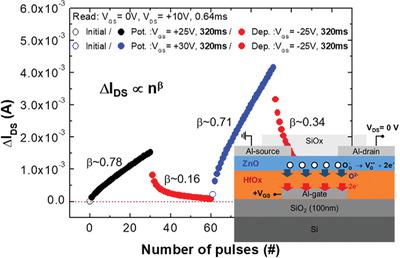当前位置:
X-MOL 学术
›
Adv. Electron. Mater.
›
论文详情
Our official English website, www.x-mol.net, welcomes your
feedback! (Note: you will need to create a separate account there.)
Nonvolatile Memory and Artificial Synaptic Characteristics in Thin‐Film Transistors with Atomic Layer Deposited HfOx Gate Insulator and ZnO Channel Layer
Advanced Electronic Materials ( IF 5.3 ) Pub Date : 2020-08-16 , DOI: 10.1002/aelm.202000412 Hyerin Lee 1 , Keonwon Beom 1 , Minju Kim 1 , Chi Jung Kang 2 , Tae‐Sik Yoon 1
Advanced Electronic Materials ( IF 5.3 ) Pub Date : 2020-08-16 , DOI: 10.1002/aelm.202000412 Hyerin Lee 1 , Keonwon Beom 1 , Minju Kim 1 , Chi Jung Kang 2 , Tae‐Sik Yoon 1
Affiliation

|
Nonvolatile memory and synaptic characteristics in thin‐film transistors (TFTs) with HfOx gate insulator and ZnO channel are investigated for the application to nonvolatile memory and artificial synapse in neuromorphic systems. Nonvolatile change of drain current induced by modulated gate stack properties is demonstrated to be applicable to nonvolatile memory operation. It also emulates synaptic weight change for learning and memory functions in artificial synapses. The TFTs with HfOx and ZnO layers deposited by sputtering or atomic layer deposition (ALD) at low temperatures exhibit tunable drain current upon applying gate pulses, featuring analog, reversible, nonvolatile changes with respect to pulse amplitude, width, interval, and repetition number. However, the TFTs with HfOx and ZnO by ALD at high temperatures show negligible change. The structural and chemical analyses reveal similarities in defective nature of sputter‐deposited and low‐temperature ALD HfOx and ZnO layers, leading to analogous drain current modulation. Also, the results of temperature‐ and voltage polarity‐dependent drain current changes and capacitance changes verify that the drain current modulation is driven by oxygen ion migration associated with defective states of HfOx and ZnO layers. It demonstrates feasibility of application of ALD‐HfOx/ZnO TFTs to nonvolatile memory and artificial synapses using modulated gate stack properties.
中文翻译:

具有原子层沉积的HfOx栅极绝缘体和ZnO沟道层的薄膜晶体管的非易失性存储器和人工突触特性
研究了具有HfOx栅极绝缘体和ZnO通道的薄膜晶体管(TFT)中的非易失性记忆和突触特性,将其应用于神经形态系统中的非易失性记忆和人工突触。由调制的栅极堆叠特性引起的漏极电流的非易失性变化被证明可应用于非易失性存储器操作。它还模拟了人工突触中学习和记忆功能的突触权重变化。具有低温下通过溅射或原子层沉积(ALD)沉积的具有HfOx和ZnO层的TFT在施加栅极脉冲时表现出可调的漏极电流,其特征是相对于脉冲幅度,宽度,间隔和重复次数的模拟,可逆,非易失性变化。然而,在高温下通过ALD进行的具有HfOx和ZnO的TFT的变化可忽略不计。结构和化学分析表明,溅射沉积的低温ALD HfOx和ZnO层的缺陷性质相似,从而导致了类似的漏极电流调制。此外,温度和电压极性相关的漏极电流变化和电容变化的结果验证了漏极电流调制是由与HfOx和ZnO层的缺陷状态相关的氧离子迁移驱动的。它展示了使用调制的栅极堆叠特性将ALD-HfOx / ZnO TFT应用于非易失性存储器和人工突触的可行性。温度和电压极性相关的漏极电流变化和电容变化的结果证明,漏极电流调制是由与HfOx和ZnO层的缺陷状态相关的氧离子迁移驱动的。它展示了使用调制的栅极堆叠特性将ALD-HfOx / ZnO TFT应用于非易失性存储器和人工突触的可行性。温度和电压极性相关的漏极电流变化和电容变化的结果证明,漏极电流调制是由与HfOx和ZnO层的缺陷状态相关的氧离子迁移驱动的。它展示了使用调制的栅极堆叠特性将ALD-HfOx / ZnO TFT应用于非易失性存储器和人工突触的可行性。
更新日期:2020-09-08
中文翻译:

具有原子层沉积的HfOx栅极绝缘体和ZnO沟道层的薄膜晶体管的非易失性存储器和人工突触特性
研究了具有HfOx栅极绝缘体和ZnO通道的薄膜晶体管(TFT)中的非易失性记忆和突触特性,将其应用于神经形态系统中的非易失性记忆和人工突触。由调制的栅极堆叠特性引起的漏极电流的非易失性变化被证明可应用于非易失性存储器操作。它还模拟了人工突触中学习和记忆功能的突触权重变化。具有低温下通过溅射或原子层沉积(ALD)沉积的具有HfOx和ZnO层的TFT在施加栅极脉冲时表现出可调的漏极电流,其特征是相对于脉冲幅度,宽度,间隔和重复次数的模拟,可逆,非易失性变化。然而,在高温下通过ALD进行的具有HfOx和ZnO的TFT的变化可忽略不计。结构和化学分析表明,溅射沉积的低温ALD HfOx和ZnO层的缺陷性质相似,从而导致了类似的漏极电流调制。此外,温度和电压极性相关的漏极电流变化和电容变化的结果验证了漏极电流调制是由与HfOx和ZnO层的缺陷状态相关的氧离子迁移驱动的。它展示了使用调制的栅极堆叠特性将ALD-HfOx / ZnO TFT应用于非易失性存储器和人工突触的可行性。温度和电压极性相关的漏极电流变化和电容变化的结果证明,漏极电流调制是由与HfOx和ZnO层的缺陷状态相关的氧离子迁移驱动的。它展示了使用调制的栅极堆叠特性将ALD-HfOx / ZnO TFT应用于非易失性存储器和人工突触的可行性。温度和电压极性相关的漏极电流变化和电容变化的结果证明,漏极电流调制是由与HfOx和ZnO层的缺陷状态相关的氧离子迁移驱动的。它展示了使用调制的栅极堆叠特性将ALD-HfOx / ZnO TFT应用于非易失性存储器和人工突触的可行性。











































 京公网安备 11010802027423号
京公网安备 11010802027423号